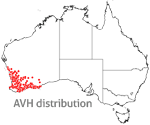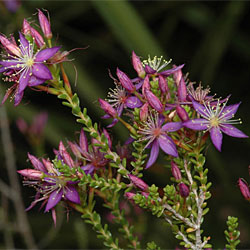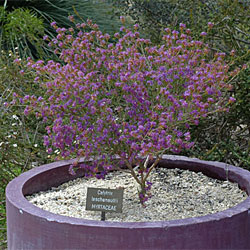Calytrix leschenaultii
Calytrix leschenaultii (Schauer) Benth.
 Of the seventy or so species that have been described in the genus Calytrix, this is the most spectacular. With its vivid, purple petals and conspicuous stamens intensifying from yellow to red, Calytrix leschenaultii makes a vibrant addition to any garden.
Of the seventy or so species that have been described in the genus Calytrix, this is the most spectacular. With its vivid, purple petals and conspicuous stamens intensifying from yellow to red, Calytrix leschenaultii makes a vibrant addition to any garden.
Calytrix are named for the fine hairs or ‘awns’ found on the calyx. One common name for members of the genus is ‘fringe myrtle’, but no colloquial name for C. leschenaultii has been recorded.
C. leschenaultii is an erect shrub which can grow to a metre in height. Its scented leaves are tiny and cling to spindly stems, giving it the classic appearance of an herbaceous member of the Myrtaceae family. Its alternating leaves are tiny, often less than 2mm, sessile, and more or less obtusely ovate. When not in flower, the plant is thus rather unremarkable; in the springtime, however, anywhere from June through to November, C. leschenaultii bursts into a fire of intense violet-coloured blooms. Its fruits are dry, indehiscent and contain a single seed.
It is not commonly seen as a cultivated plant outside of botanic gardens, but this does not at all reflect the ease with which it can be grown. It requires very little maintenance, is not susceptible to pathogens, and tolerates the extremes of the Australian environment. C. leschenaultii is native to the south-western corner of Western Australia, but does well in the temperate climate of the east coast. Providing the plant with a sunny position, preferably west-facing, and well-drained, sandy soils should see it grow quickly from a cutting. As with most Australian natives, propagating C. leschenaultii from seed is a much more temperamental process.
Inherently drought-resistant and hardy, C. leschenaultii can also survive frosty winters. Surrounding the base of the plant with smooth stones to retain heat, and keeping it out of low-lying or cold areas in the garden, will protect the plant from cold stress during the winter months.
To prevent the plant contracting fungal infections, it should be placed at a sufficient distance from others. C. leschenaultii can grow just as well in a pot as in the garden, and this is one clever way of ensuring it doesn’t become infected while making a feature of the incredible flowers. Pots and raised garden beds also allow maximum drainage of the soil.
C. leschenaultii is a horticulturalist’s dream, easy to cultivate and truly stunning.
Text by Laura Johnson (2012 Student Botanical Intern)
Name Meaning: Calytrix leschenaultiiCalytrix- from two Greek words meaning calyx and hair, alluding to the long fine calyx tips leschenaultii – after the French botanist, Jean B.C.T. Leschenault de la Tour (1773-1826) |
References
ANBG staff (1972) Calytrix tetragona, Growing Native Plants. Available at http://www.anbg.gov.au/gnp/gnp2/calytrix-tetragona.html. [Accessed February 2012].
Archer, W. (2011) Calytrix leschenaultii - Myrtaceae. Available at
http://esperancewildflowers.blogspot.com.au/2011/06/calytrix-leschenaultii-myrtaceae.html [Accessed February 2012].Australian Native Plants Society (Australia) (2007) Calytrix leschenaultii. Available at http://anpsa.org.au/c-lesch.html. [Accessed February 2012].
Blombery, A.M. (1980) Australian Native Plants (4th ed.), Angus and Robertson Publishers.
Clarke, G. (2001) Growing Calytrix, Australian Plants Online 21. Available at http://anpsa.org.au/APOL21/mar01-3.html. [Accessed February 2012].
Clarke, I. and Lee, H. (2009) Name That Flower. Carlton, Melbourne University Press.
Coleman, H.R. (2008) Calytrix: Scientific Description, in FloraBase: The Western Australian Flora, Western Australian Herbarium, Department of Environment and Conservation. Available at http://florabase.dec.wa.gov.au/browse/profile/21817 [Accessed February 2012].
Fairall, A. (1970) West Australian Native Plants in Cultivation. Pergamon Press Australia.
Lullfitz, G. (1978) Grow the West's Best Native Plants, Periodicals Division, West Australian Newspapers.
Orchard, A.E. (1999). A History of Systematic Botany in Australia, Flora of Australia, 2nd edn, 1: 11-104, ABRS/CSIRO Australia.
Paczkowska, G. (1995) Calytrix leschenaultii, in FloraBase: The Western Australian Flora, Western Australian Herbarium, Department of Environment and Conservation. Available at http://florabase.dec.wa.gov.au/browse/profile/5465 [Accessed February 2012].
![An Australian Government Initiative [logo]](/images/austgovt_brown_90px.gif)



